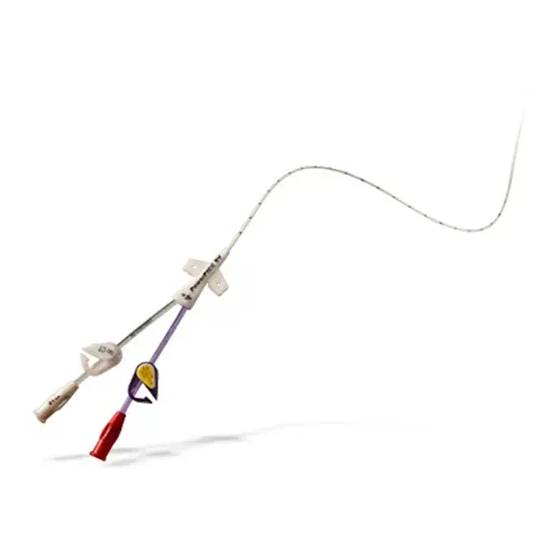Table of Contents
Advertisement
An issued or revision date for these instructions is
included for the user's information. In the event two
years have elapsed between this date and product use,
the user should contact Bard Access Systems, Inc. to
see if additional product information is available.
Revised date: November 2010
*Bard, PowerPICC, and StatLock are trademarks and/or
registered trademarks of C. R. Bard, Inc.
© Copyright 2010 C. R. Bard, Inc.
All rights reserved.
Bard Access Systems, Inc.
605 North 5600 West
Salt Lake City, UT 84116 USA 1-801-522-5000
Clinical Information Hotline:
Ordering Information:
www.bardaccess.com
1-800-443-3385
1-800-545-0890
0727954 / 1011R
Polyurethane Radiology
Catheters with
Microintroducer Set
Instructions For Use
Bard Access Systems
Advertisement
Table of Contents

Summary of Contents for Bard PowerPicc SV
- Page 1 Bard Access Systems, Inc. to see if additional product information is available. Revised date: November 2010 *Bard, PowerPICC, and StatLock are trademarks and/or registered trademarks of C. R. Bard, Inc. © Copyright 2010 C. R. Bard, Inc. All rights reserved.
- Page 2 Ne w I m p o r t a n t I nf or m a t ion: N ew Impo r t a n t I n f o r ma t i o n : • Contrast media should be warmed to body temperature prior to power injection. Warning: Failure to warm contrast media to body temperature prior to power injection may result in catheter failure.
- Page 3 I nd icatio n s The PowerPICC* SV catheter is indicated for short or long-term peripheral access to the central venous system for intravenous therapy, blood sampling, power injection of contrast media, and allows for central venous pressure monitoring. For central venous pressure monitoring, it is recommended that a catheter lumen of 20 gauge or larger be used. Catheter Size Maximum Flow Rate 3 F Single Lumen...
- Page 4 • Carefully read and follow all instructions prior to use. • Federal (U.S.A.) law restricts this device to sale by or on the order of a physician. • Only qualified health care practitioners should insert, manipulate and remove these devices. •...
- Page 5 I ns er tio n I ns tru cti on s 1. Identify the Vein and Insertion Site 1. Apply a tourniquet above the anticipated insertion site. 2. Select a vein by assessing patient anatomy and condition. Recommended veins are cephalic, basilic or median cubital basilic. The PowerPICC* SV catheter features a reverse-taper catheter design. Caution: Placement of larger catheters at or below antecubital fossa may result in an increased incidence of phlebitis.
- Page 6 8. Measure Distance to Tip Location 1. Using fluoroscopic control, determine the correct catheter length by advancing the guidewire to the desired catheter tip location in the SVC. 2. Once the guidewire tip is in proper position, mark the length by clamping forceps onto the guidewire at the skin site. 9. Removing Dilator and Guidewire 1.
- Page 7 14. Aspirate and Flush 1. Attach primed extension set and/or sterile normal saline-filled syringe. 2. Aspirate for adequate blood return and flush each lumen of the catheter to ensure patency. In addition, lock each lumen of the catheter with heparinized saline. Usually, one mL per lumen is adequate. Caution: To reduce potential for blood backflow into the cathetr tip, always remove needles or needleless caps slowly while injecting the last 0.5 mL of saline.
- Page 8 Warning: When using alcohol or alcohol containing antiseptics with polyurethane PICCs, care should be taken to avoid prolonged or excessive contact. Solutions should be allowed to completely dry before applying an occlusive dressing. Chlorhexidine gluconate and/or povidone iodine are the suggested antiseptics to use. Warning: Alcohol should not be used to lock, soak or declot polyurethane PICCs because alcohol is known to degrade polyurethane catheters over time with repeated and prolonged exposure.













Need help?
Do you have a question about the PowerPicc SV and is the answer not in the manual?
Questions and answers